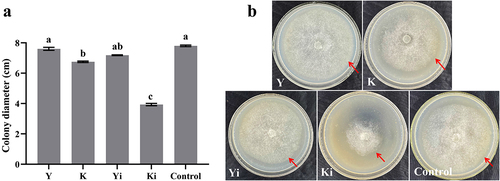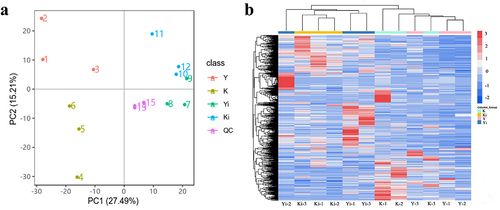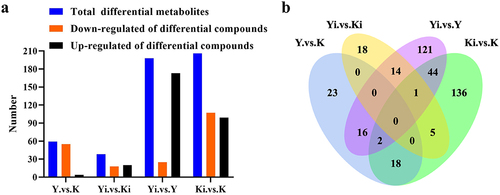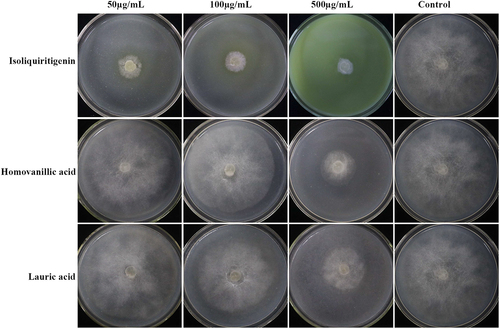Figures & data
Figure 1. Resistance identification of Yunyan87 and K326 against TBS. (a) The incidence rate of Yunyan87 and K326 inoculated with P. nicotianae for 4 and 8 days. (b) TBS symptoms of tobacco plants 8 days with P. nicotianae (***, p < 0.001; ****, p < 0.0001; t test; the error bars represent the standard deviation of three repetitions).

Figure 2. Effects of root exudates from Yunyan87 and K326 on the mycelial growth of P. nicotianae. (a) The colony diameter of P. nicotianae treated with root exudates of Yunyan87 and K326 for 4 days. (b) Mycelial growth of P. nicotianae after 4 days treatment with root exudates of Yunyan87 and K326. Yi and Y represent root extract from pathogen inoculation and non-inoculation of Yunyan87, respectively; Ki and K represent root extract from pathogen inoculation and non-inoculation of K326, respectively; different lowercase letters marked on the column indicate significant differences between groups at p < 0.05; the error bars represent the standard deviation of three repetitions.

Figure 3. Principal component analysis (a) and hierarchical clustering analysis (b) of metabolites of different tobacco cultivar non-inoculation and inoculation. Yi and Y represent root extract from pathogen inoculation and non-inoculation of Yunyan87, respectively; Ki and K represent root extract from pathogen inoculation and non-inoculation of K326, respectively.

Figure 4. The numbers of differential compounds before and after inoculation of P. nicotianae in both tobacco cultivars. (a) Histogram. (b) Venn diagram. Yi and Y represent root extract from pathogen inoculation and non-inoculation of Yunyan87, respectively; Ki and K represent root extract from pathogen inoculation and non-inoculation of K326, respectively.

Table 1. Potential key differential metabolites in tobacco root exudates of tobacco Yunyan87 and K326.
Figure 5. Mycelial growth of P. nicotianae after 4 days treatment with isoliquiritigenin, homovanillic acid and lauric acid with strong inhibitory activity.

Table 2. Effects of compounds on the growth of mycelium of P. nicotianae.
Table 3. Inhibitory activity of four compounds on mycelium growth of P. nicotianae.
Figure 6. Pot control effect of isoliquiritigenin, lauric acid and oxadixyl·mancozeb against TBS. (a) The TBS incidence of Yunyan87 inoculated with P. nicotianae for 4 and 11 days after treatment with two compounds and oxadixyl·mancozeb. (b) TBS symptoms in tobacco plants 11 days post-inoculation with P. nicotianae after treatment with three compounds and oxadixyl·mancozeb. Different lowercase letters marked on the column indicate significant differences between groups at p < 0.05; the error bars represent the standard deviation of three repetitions.

Supplemental Material
Download Zip (283 KB)Data availability statement
All the data relevant to this study are included in the article or uploaded as Supplementary Materials.
